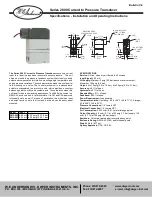
FCC ID: K6630163X3S
IC ID: 511B-30163X3S
Alignment
2/6
Vertex Standard Co,. Ltd.
Required Test Equipment
RF Signal Generator with calibrated output level at 200 MHz
Deviation Meter (linear detector)
AF
Millivoltmeter
SINAD
Meter
Inline Wattmeter with 5% accuracy at 200 MHz
Regulated DC Power Supply: 13.8 VDC, 10A
50-ohm Non-reactive Dummy Load: 30W at 200 MHz
Frequency Counter: >0.1 ppm accuracy at 200 MHz
AF Signal Generator
DC Voltmeter: high impedance
VHF Sampling Coupler
AF Dummy Load: 4 Ohms, 10 W
Oscilloscope
Spectrum
Analyzer
GX3500S Marine Transceiver
CMP25 Remote Access Microphone
Alignment Preparation & Precautions
A dummy load and inline wattmeter must be connected to the main antenna jack in all
procedures that call for transmission. Correct alignment is not possible with an antenna.
After completing one step, read the following step to determine whether the same test
equipment will be required. If not, remove the test equipment (except dummy load and
wattmeter, if connected) before proceeding.
Correct alignment requires that the ambient temperature be the same as that of the
transceiver and test equipment, and that this temperature be held constant between 20°C
and 30°C (68°F and 86°F). When the transceiver is brought into the shop from hot or cold
air it should be allowed some time for thermal equalization with the environment before
alignment. If possible, alignments should be made with oscillator shields and circuit boards
firmly affixed in place. Also, the test equipment must be thoroughly warmed up before
beginning.
Note: Signal levels in dB referred to in this procedure are based on 0 dBµ = 0.5 µV (closed
circuit).
Overview of Test Mode
The test mode has been build in the microprocessor in order to adjust and confirm the
performance of transceiver.
The purpose is to adjust transceiver simply and to confirm the performance of
transceiver smoothly.
























